Back when, the first handgun I had extensive experience with was a loaner. The owner of the air freight outfit at the local municipal airport was a bit of a gun guy. He had a nickel Colt Frontier Scout 22. It had the shorter (4 5/8”?) barrel. The frame, grip frame and loading gate was made of something called ‘Zamak alloy’ or something. I’ve since read that it’s heavier than aluminum alloys used at the time in firearms manufacture. According to information on the internet, the material has zinc as a base metal in an alloy with aluminum, magnesium, and copper.
He had it in a nicely fitted holster that fit low-slung under a cartridge belt in the fashion of the rigs worn by TV Western actors of the 1960s.
This part of the Colt handgun line was made from 1960 to 1970.
He loaned me that gun, made me promise not to do anything stupid with it (I was a teenager at that time), and sent me on my way. The bullet loops were loaded full — and I didn’t use a single round of his ammo.
The bright nickel shined in the sun, particularly the sights. It was not a bullseye gun, but I learned to make some really good hits with it. I was particularly fond of the uncheckered walnut stocks on the classy little handgun.
I later saw ads for the Colt New Frontier. With a nicely case colored frame and adjustable sights, I was hooked. Sadly, I never owned one of those guns.
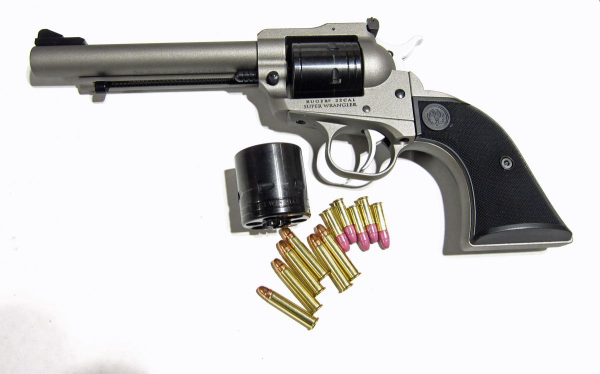
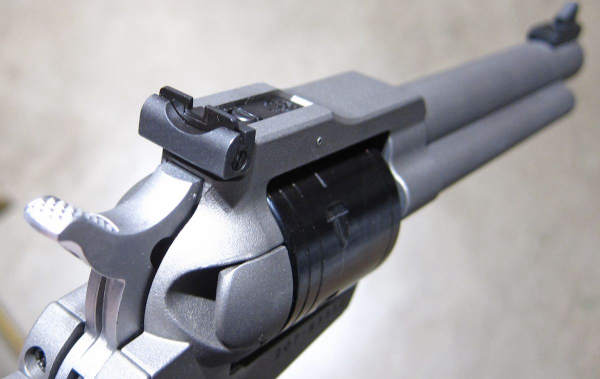
Later today, Ruger will formally announce the availability of their “Super Wrangler.” With a 5.5” barrel, the new gun has adjustable sights. And a pair of cylinders, one for .22 Short, Long or Long Rifle, and a second cylinder for the 22 WMR cartridge.
I’m thinking I finally made it.
With the barrel only around an inch longer than the earlier Wrangler, it still weighs in at 37.7 oz. – 7.7 ounces more. That’s quite a difference. Like the older Colt, the Ruger uses zinc and aluminum castings for cost savings as well as weight savings over steel components.
The cylinders are bored and chambered for six rounds. The LR cylinder features three identifying grooves – the instruction manual insert reminds us we can shoot 22 Short, Long or Long Rifle; remember to properly clean the chambers after using the shorts. The 22 WMRF cylinder has two grooves and the legend “22 WIN MAG” marked between the grooves.
The instruction manual insert also shows how to adjust the rear sight for elevation and windage, a handy feature.
A quick range trip set on a cold morning – the only dry day in weeks – where the 26° temperature combined with extreme humidity for a miserable morning.
Frosty.
As the sun was rising, I set up the gear to get velocities from 22 LR and Magnum ammo.
I found the following results
22 LR
Brand – Type (Avg. Velocity - FPS)
Win. Super-X 40 gr (1071)
CCI Standard Vel 40gr (981)
Fed. AutoMatch 40gr (1106)
Win. Super-X PowerPoint (1132)
22 Magnum
CCI Maxi-Mag (1516)
Win. Supreme 30gr HP (1867)
Hornady 30gr V-MAX (1859)
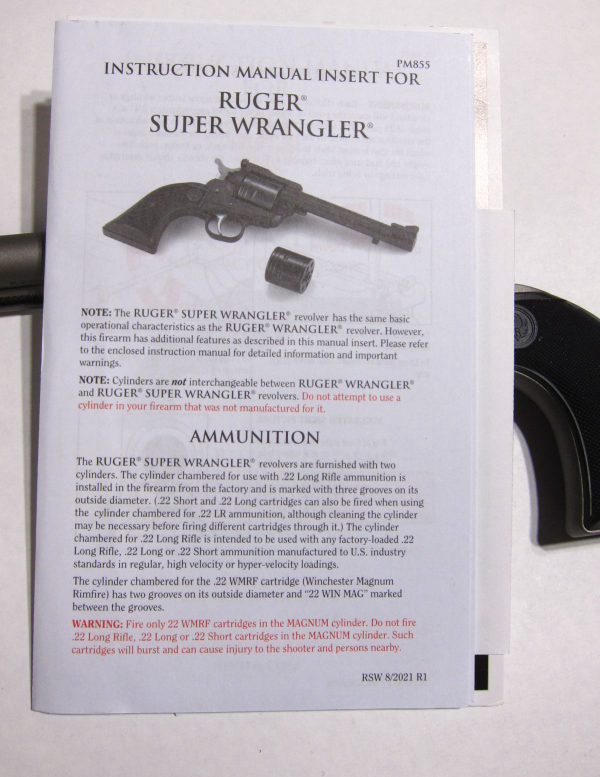
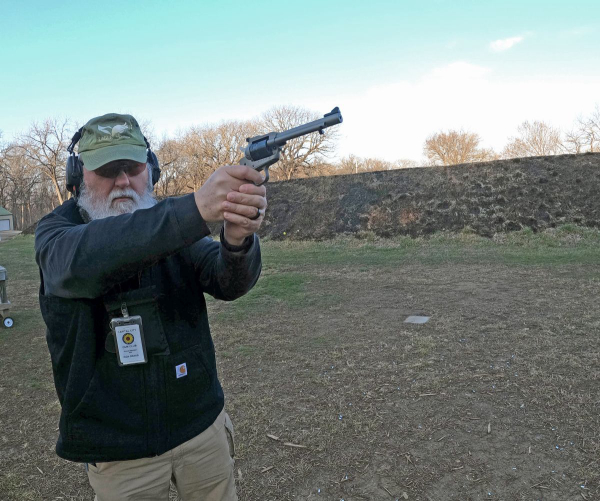
The 5.5” Ruger barrel made good use of the power of the 22 Magnum cartridge with the closest maximum average velocities of the LR coming in 384 feet-per-second slower than the slowest average Magnum round. That’s a significant difference.
Now could I hit anything?
Starting at the 25-yard line from a seated rest, I put five rounds of Winchester Super-X 40gr RN into 3 ½”, with the best three going into 1 3/8” group. The CCI Standard Velocity round was slightly smaller, with the five-round group shooting a 3 3/8” group with the best three rounds going into an inch. This was nearly duplicated by the Federal AutoMatch load. The normally very good Winchester Super-X PowerPoint – which shows good performance from every gun in which I tried it – showed slightly larger groups (around 4”, with 3/5 in 1 ¾”).
I try not to put too much stock in the absolute numbers above due to weather conditions and the elderly status of the shooter. Still, the consistency showed I was consistently making the same errors – and that the gun was working fine.
With 22 Magnum ammo – which all hit close to the sights as I had zeroed for 22 LR – the CCI Maxi-Mag shot a 2 3/8” group (3 into 1 ¼”), the Winchester Supreme 30 grain HP shot into 3 ½” (three into 2”) and the Hornady shot a five-inch group, with three into 2 ½”.
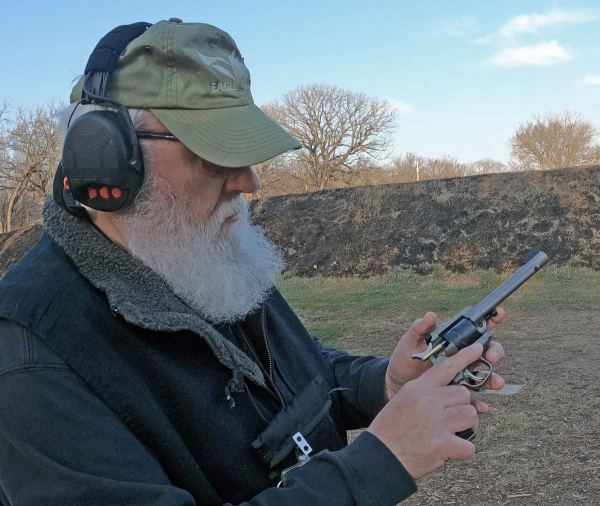
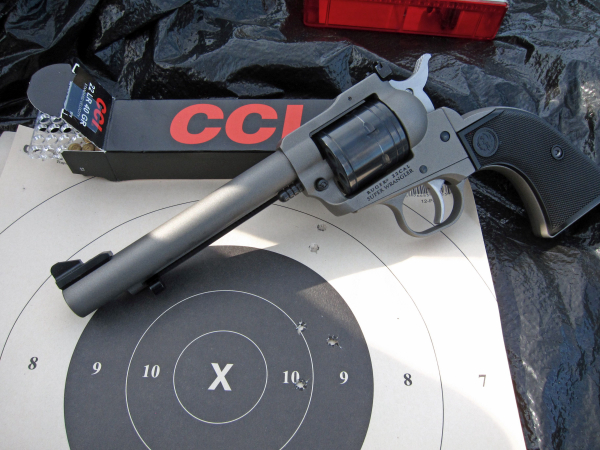
I was really cold by then. My fingers were numb enough that it was a chore to load the cylinder and I couldn’t feel the trigger.
The chambers on both cylinders are rebated to enclose the case rims, a smart move. You have to ensure each round is seated into the recessed chamber before turning the cylinder. Failure to do so is readily apparent when the cylinder rotation binds up.
Like other Wranglers of my experience, the cylinder free-wheels; if you go too far past the empty chamber you’re trying to load, just roll the cylinder back.
Some of these reviews will likely come out with “value for the price” statements. Not this one.
The Super Wrangler is a practical field gun for the experienced and instructional handgun for new shooters. It’s got enough heft to hold still for field positions when hunting or attempting to rid the property of pests. It’s safe to fully load up with the Ruger transfer bar safety system. The new gun comes in Cerakote finishes – black, bronze and, as shown here, silver.
It doesn’t have the “Colt clicks” when rolling the hammer back, but that’s something that isn’t noticed for long. It is a better shooter than that old Frontier Scout largely due to the sights.
It’s unquestionably fun and the cost doesn’t make the accountant weep. Now to arrange for leather.
-- Rich Grassi